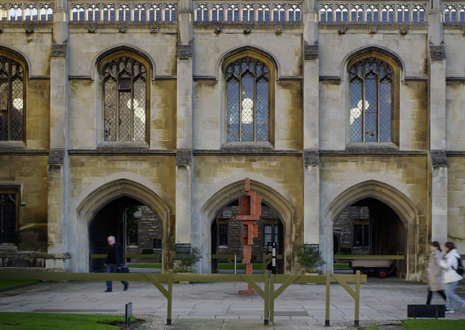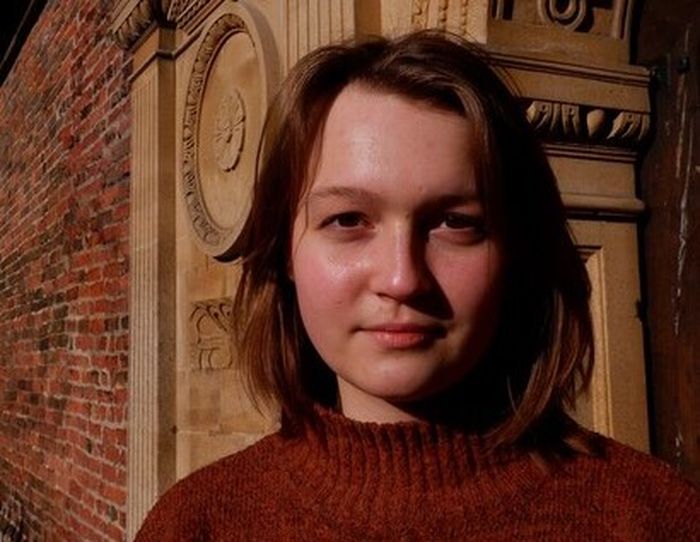‘It sends the wrong message for me’: students and staff on the proposed Turing statue at King’s
The Anthony Gormley designed statue of one of the College’s most famous alumni is finally set to be built. But students are unhappy about the location of the statue and its potential meanings

King’s College will soon have a new permanent artwork on its grounds. 3.668m of Corten steel, arranged in blocks that will weather into warm rust and which seem to hang, provisionally, in the balance: this is the sculpture of King’s College alumnus and second world war codebreaker Alan Turing by renowned Trinity alumnus Antony Gormley.
The freestanding sculpture, part of Gormley’s “Slabworks” series, represents a human form whose pensively-defensive silhouette was achieved using pillar construction techniques. In the College's own words this design is meant to reflect “both Turing’s brilliance and his vulnerability; but at the same time the sculpture also embodies the transformation of the industrial into the information age – a transformation in which Turing played such a crucial part.”
The keeper of the College collections, professor Nicolette Zeeman, told Varsity she was delighted at the “long overdue” commemoration of Turing, who was not pardoned until 2013 for the homosexuality he was criminalised for.
“I have been working for over four years with the members of King’s College, various bodies concerned with the application, and with Antony Gormley himself to secure this planning permission. So, I am of course delighted at this enlightened decision by the Cambridge City Planning Committee. We are thrilled that it will be with the work of such a distinguished sculptor as Antony Gormley. Gormley came to the College several years ago, bringing a quarter-size maquette of the figure; he spoke inspirationally about it.”
The Turing sculpture is set to be installed adjacent to the main path of the King’s Front Court to the bridge in the recessed corner by the Library arches. Deliberately chosen by Gormley and the College, this location is the meeting point for four routes within the College, including the route between the porter’s lodge and back gate.
The sculpture has, however, been the centre of controversy over its location and design.
The city council’s conservation officer, echoing Historic England’s conclusion that the sculpture would cause “some harm” to the College’s historical preservation in April 2020, advised “a smaller sculpture, a material of more affinity with its context, or a less prominent location might also have some such benefits whilst avoiding the harm that HE identifies.”
An alternative site, close to the riverbanks in the garden to the Kennedy Building, was rejected for fear the sculpture would “take on the status of an isolated icon or some kind of trophy”. Another proposal for King’s Parade was likewise rejected for being “too isolating and monumentalising”.
Students in the College are broadly supportive of the proposed statue. One student said: “I’m very much in favour of commemorating Turing. He’s probably our most important alumnus and certainly preferable to the morally dubious characters who usually get reception at King’s.”
However, there were concerns about the potential meanings of the statue: “Who Alan Turing was, his identity as a gay man, defined so much of his life – that’s a key part of what we should be trying to commemorate. But to abstract the statue beyond any semblance of the man is going in the opposite direction, in my view. Placing the statue like this, right outside all the old buildings creates a contrast which gives the impression of Turing as incongruous and an outsider in this place. It sends the wrong message for me.”
Another King’s student said: “It’s a really weird place to put a statue. Obviously, it should be somewhere people can see it but right outside the entrance to Webb’s Court just strikes me as odd.”
The news of the Turing sculpture’s approval follows the controversy surrounding another Gormley sculpture to be installed in Imperial College, London. Titled Alert, the University’s student union objected to its potentially phallic form: “There is nothing inherently wrong with phallic imagery in art. However, the phallic interpretation’s preoccupation with the penis could be considered inappropriate for a grand public display, especially given the statue’s size.”
It has yet to be announced when the Turing sculpture will be installed. Acknowledging the city council’s decision to approve the sculpture, Historic England said in a statement “We recognise the importance of the Turing Memorial Sculpture to King’s College and the benefits of displaying the work of prominent contemporary sculptor Sir Antony Gormley.”
 Comment / Cambridge students are too opinionated 21 April 2025
Comment / Cambridge students are too opinionated 21 April 2025 Comment / Does the AI revolution render coursework obsolete?23 April 2025
Comment / Does the AI revolution render coursework obsolete?23 April 2025 Comment / Cambridge’s tourism risks commodifying students18 April 2025
Comment / Cambridge’s tourism risks commodifying students18 April 2025 News / News in brief: campaigning and drinking20 April 2025
News / News in brief: campaigning and drinking20 April 2025 Interviews / Meet the Chaplain who’s working to make Cambridge a university of sanctuary for refugees20 April 2025
Interviews / Meet the Chaplain who’s working to make Cambridge a university of sanctuary for refugees20 April 2025






